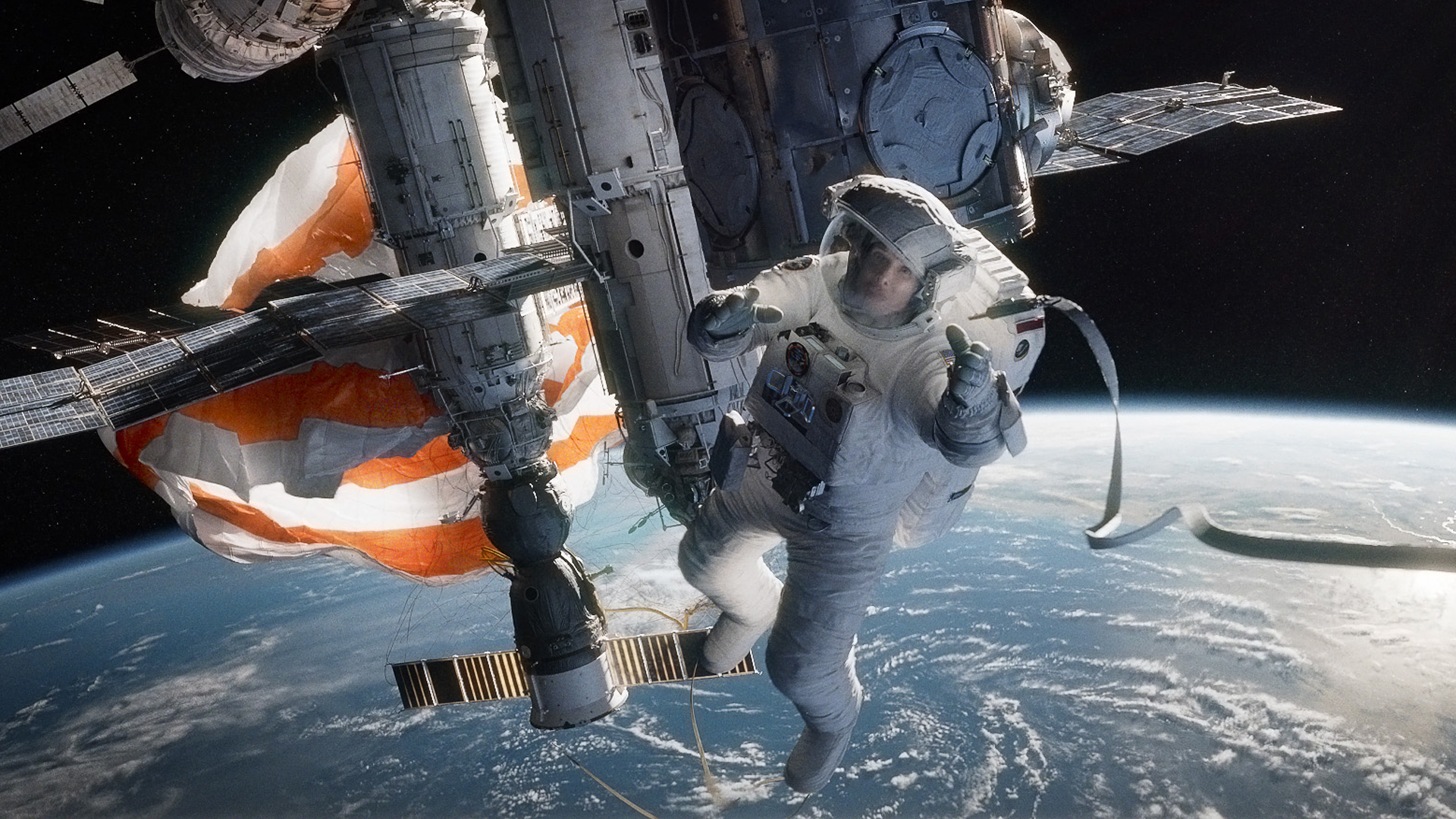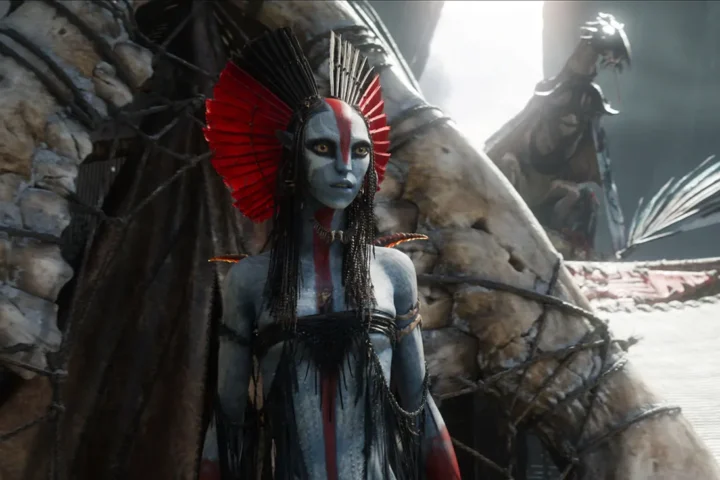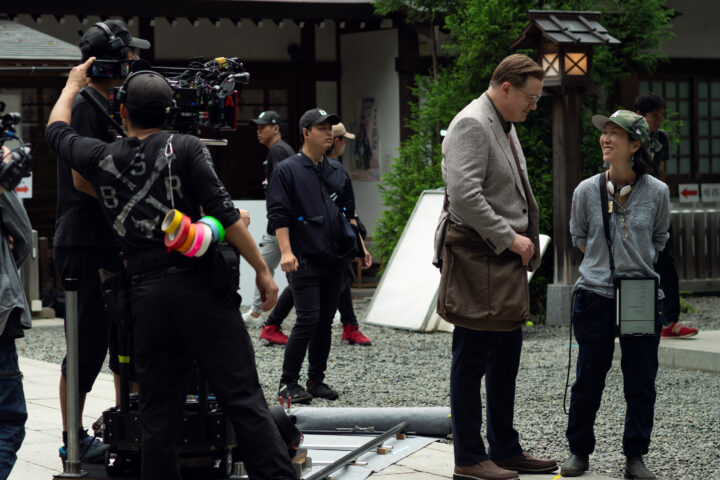We so often indulge in hyperbole about movies that when one comes along that truly merits such, simply saying it’s extraordinary doesn’t seem enough. But that’s the case with Alfonso Cuarón’s magnificent Gravity, a simple yet profound meditation on survival starring Sandra Bullock as an inexperienced astronaut cast into deep space when her satellite station is destroyed. It’s deep space, not deep drama—but it works beautifully.
As the film opens, novice astronaut and Midwestern doctor Ryan Stone (Bullock) and veteran Matt Kowalsky (George Clooney) are nearly 400 miles above Earth on a mission to repair a damaged station when instructed by NASA to quickly abort—the Russians have destroyed one of their satellites, the act of which has created a massive debris field on rapid approach. When their ship is obliterated and crew killed, the pair (and we) are sent hurling into blackness, tethered only by a tenuous cord with diminishing oxygen and jetpack fuel.
This opening 13 minutes—a single, unbroken shot that establishes both characters (archetypal buddies, the rookie and the pro), their rapport and the disaster—is visual innovation of a high order, employing meticulously detailed green screen acting and CGI to create a dimensionally spatial wonderland that leaves you completely gobsmacked, a foreign place so convincing and immediate and terrifying as to actually place us there, directly inside the helmets, gaping with awe at Earth below while hope of survival, and contact with home, is lost. Earth looms large in front of our heroes—but how to get there? And for Stone, we learn, it may not be worth trying.
The remainder of the picture is one inventive set piece of peril after another, as Stone struggles to reach, enter and repair a number of faulty satellite stations and potential escape pods. Cuarón masterfully stacks the deck against her, giving her mere moments of reprieve from the elements—once she obtains oxygen, she has to contend with fire; once the fire is under control, she’s struck by speeding debris. If screenwriting rules dictate that you must give your characters obstacles to overcome, then Gravity is textbook. But while Stone gradually mans up to the strenuous physical demands of navigating this nightmare, she also wrestles with an internal crisis that gives the director a visual masterstroke in the gravity-defying tears wept during a brief but affecting contemplation of mortality.
A trim 91 minutes (though by my watch the credits rolled around 85) written by Cuarón and son Jonas, Gravity is direct in conceit and theme but complex in design, a space epic made in eye-popping 3D that, like Avatar, shows us something completely new and breathtaking, employing technology to serve its story rather than the generally accepted hardware over substance tenet that’s infected most of today’s movies.
Gravity is about nothing more, nor less, than the human will to survive. Yet what is so special here is that Stone needs to find that will to begin with; she’s a lonely shell of a woman who contemplates if there really is anything to return “home” to. Surviving the traumas of deep space and isolation are hard enough; surviving the ennui Stone feels at a loss she’s experienced on Earth is another story altogether.
Cuarón, who hasn’t made a film since 2006’s Children of Men, spent years crafting Gravity while being rejected by scores of actresses, namely Angelina Jolie who would have also been effective in the role, given her marked physicality in movies like Wanted and Salt, and her ability to emote with precision, for which she’s won an Oscar and several Globes.
But Gravity, despite the welcome presence of Clooney’s charm, is all Bullock’s show, and the world’s most likable actress digs in with newfound rigor and intensity. There isn’t another star today as engaging as Bullock in terms of sheer niceness, and Ryan Stone is a role that takes full advantage of this—we like her, and want her to be safe. And that is all.
Masterful as it is, Gravity is also appropriately scaled and rooted in actual science; this isn’t a special effects extravaganza with action climaxes and phony genre tropes. Pared down to the essence of survival and wound up as suspense, Gravity doesn’t afford much room for character, per se, at least not in the traditional sense. Yet the film feels emotionally rousing in Stone’s quest, and there’s real exaltation near the end as Cuarón suggests the rebirth of man in a direct visual metaphor providing a much-needed catharsis.
Some have compared Gravity to 2001: A Space Odyssey, an understandable equation in terms of its euphoric, enveloping aesthetic. Certainly as a physical creation Gravity trumps Kubrick’s masterwork simply based on current and available technology. And while James Cameron has gone on record that Gravity is the best space picture of all time (certainly it is the most convincing in terms of its depiction of the astronautical experience), it is very much a modern movie, told and paced at breakneck speed—and not quite reaching to the stars with contemplation. And that’s just fine.
At times during Ryan’s journey I was reminded of Jodie Foster’s travels through Robert Zemeckis’ Contact wormhole to be reunited with her “father” on an interstellar beach, and that scene’s emotional quotient. Some of that feeling is here in Gravity, but the chief engine of the picture is staying alive and getting home; internal diversions are not on the first order.
Gravity is groundbreaking and transporting.
4 stars.




Great review! Loved the movie, and IMAX 3D was definitely the best way to see it!
Kristina!
Thanks for commenting. So glad you enjoyed it. The IMAX presentation is breathtaking. It really is another game-changer on the level of Avatar and a reminder of what movies, and imagination, are capable of creating.
Lee